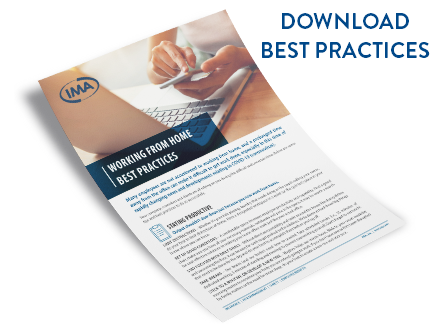COVID-19
Best Practices for Working from Home
Your company, coworkers and clients are all relying on you during this difficult and uncertain time.
Below are some tips and best practices to do so successfully.
Working from Home Best Practices
Many employees are not accustomed to working from home, and a prolonged time away from the office can make it difficult to get work done, especially in this time of rapidly changing news and developments relating to COVID-19 (coronavirus).
Staying Productive Output shouldn’t slow down just because you now work from home.
LIMIT DISTRACTIONS – Whether it’s your kids playing, laundry that needs doing or the couch calling your name, do your best to limit distractions at home. Have a designated workspace in a quiet (or the quietest) place in your home where you can focus.
SET UP GOOD CONDITIONS – A comfortable space increases employee productivity and capability. Find a good chair, make sure you have all your necessary materials, notebooks and pens in the space. It may be worth a search for cost-effective solutions to making your home office work just like your actual office.
STAY FOCUSED WITH DAILY GOALS – Without direct accountability and tasks around the house like doing dishes and vacuuming the floor, it can be easy for work to get pushed to the sidelines. Write down at least three big things that need to be done for the day and do your best to accomplish them before you log off.
TAKE BREAKS – Our brains (and our backs!) need time to unwind. Take scheduled breaks (i.e., 25 minutes of dedicated working, 5 minutes of standing and moving) to prevent overworking yourself. Don’t forget to eat lunch!
STICK TO A ROUTINE OR DEVELOP A NEW ONE – Rhythm helps our minds focus. Stick to your usual weekday morning routine to convince your body you are indeed going to work. If you don’t have one or if it’s been disrupted by family matters or the need for more sleep, do your best to create a new one and stick to it.
Staying Social Not only are we dealing with working from home (which many people do regularly), we’re also coping with social distancing, unable to see family members and friends.
UTILIZE CHATS/IMS – Reach out to your coworkers and talk about benign things – you know, water cooler stuff. Connecting with coworkers on a personal level, even if you’re not at work, is a great way to be social.
CONNECT WITH YOUR TEAM REGULARLY – We all have different tasks we’re working on, so check in and make sure you’re helping each other and staying up-to-date on the latest development.
CONNECT ON PHONE OR VIDEO CALLS REGULARLY – Email is easy, but it’s not very social. Connecting via phone (especially video calls!), hearing real voices and eye contact will help you feel less alone.
“MEET” FOR VIRTUAL HAPPY HOURS – Clock out but sign on for a drink. Why lose the fun of regular happy hours when you can drink wine or sparkling water at home on the couch and connect with your coworkers?
Working Well Efficient and quality work is still an expectation for many employees.
STAY ACCESSIBLE – Sometimes, you need to run errands during the workday, or your break is walking your dog outside. With COVID-19 related issues, a lot of work right now is timely. Bring your phone with you when you’re out so coworkers can reach you. If you can’t be available, be sure to communicate this to your coworkers as well.
OVERCOMMUNICATE – There’s a reason many meetings are face-to-face. Communication solely through phone and emails opens the door for miscommunication, no communication and uncertainty. In your emails and phone conversations, make sure to clarify tasks, ask questions and ask if anyone has questions. Collaboration tools using cloud data can help keep all conversations in one place and all documents updated in real-time.
BE RESPECTFUL – With limited face-to-face communication, ensure your electronic communications are thoughtful and polite. Humor doesn’t always translate electronically.
STAY POSITIVE – Times are uncertain, and that means higher stress levels. Offer encouragement to your coworkers and don’t be afraid to ask for help and support when you need it. Review your company’s benefits offerings if you need additional assistance; you may have access to online mental wellness resources and other tools.
TRANSPARENCY – Your work hours are (likely) different now, especially if you’re a parent. If you’re watching the kids in the morning and working at night, your clients and coworkers should know so they’re aware of delayed response time. Everyone should be understanding, but being transparent about your work hours will help with collaboration.
SEPARATE YOUR ON-WORK AND OFF-WORK TIMES – When the office is a few steps away from your bed, it can be hard to separate work time from time off. Take a break, breathe and clear your mind so you can be wholly present at home.
Take the COVID-19 situation seriously and do your part to keep yourself and others safe—access resources from the Centers for Disease Control and Prevention (CDC) and the World Health Organization. The Johns Hopkins Center for Systems Science and Engineering has developed an online dashboard tracking the spread of the COVID-19 outbreak. With the continued spread of the disease, we should all consider ourselves at potential risk of exposure given the widespread nature of the virus, and should not assume that lack of contact with a person known to have tested positive will prevent such risk.
